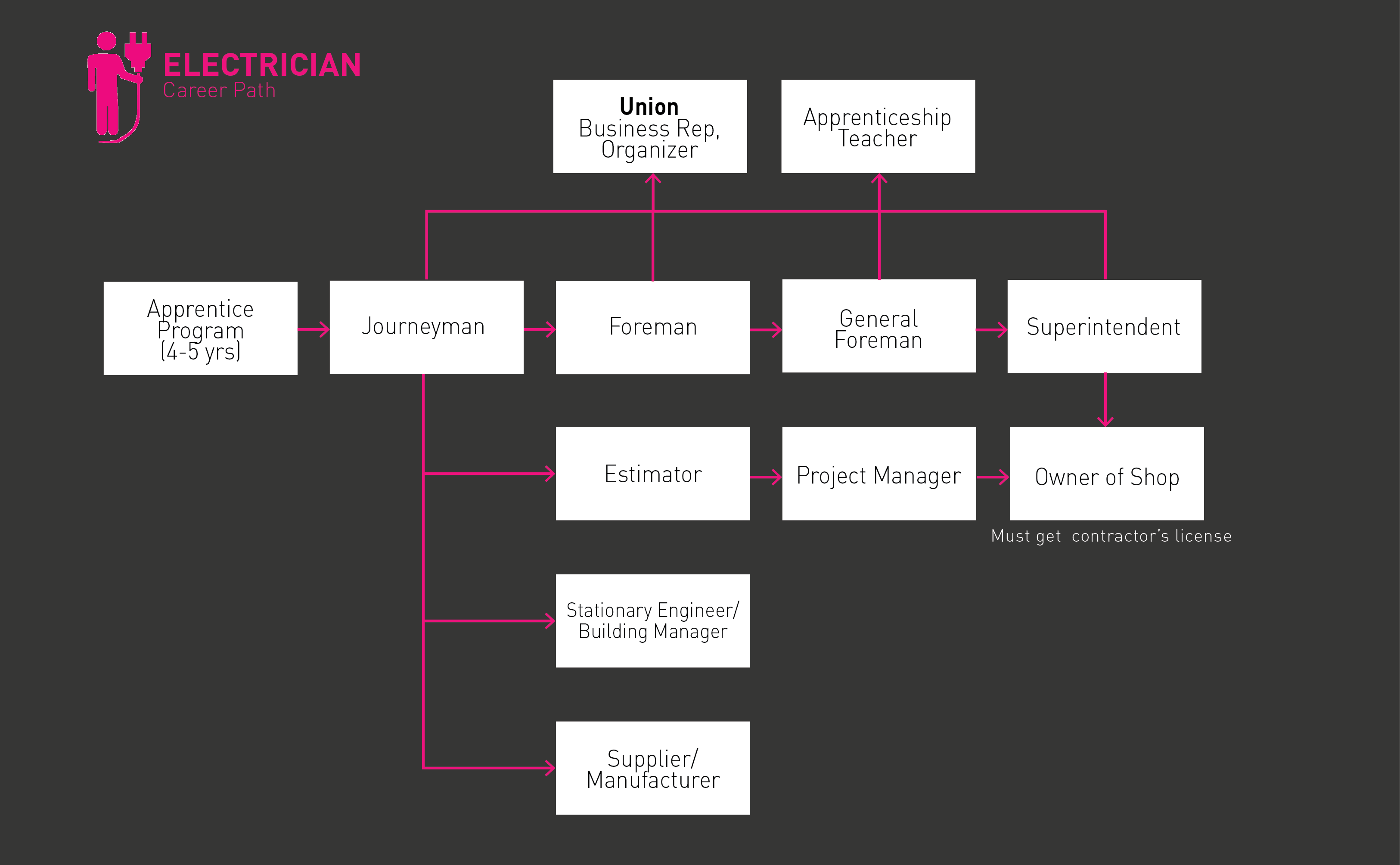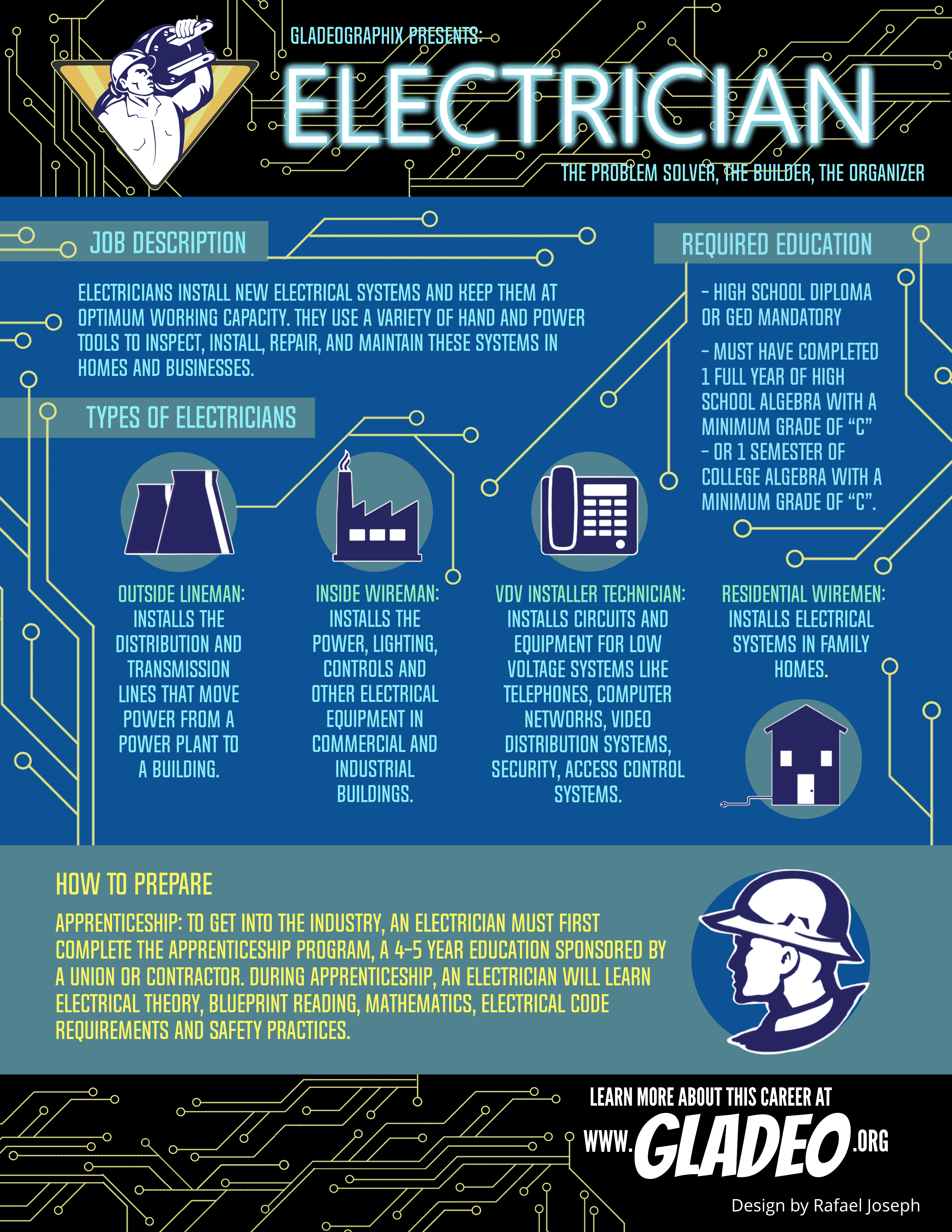Reflektory
Podobne tytuły
Control Electrician, Electrical Journey Person, Electrical Troubleshooter, Electrician, Housing Maintenance Electrician, Industrial Electrician, Inside Wireman, Maintenance Electrician, Paper Mill Electrician, Wireman, Line Workers
Opis stanowiska
Electricians install and maintain electrical systems in homes, businesses, and factories.
Nagradzające aspekty kariery
- “I build something every day that you can see and touch.”
- A sense of accomplishment when you finish a project
- Autonomy: You can work as much and as little as you want. It’s project-based.
- Typically you start at 6:30am-3:30pm: Able to do other projects in the afternoon.
- Work with your hands!: “When you are mechanically inclined, the trades are excellent for that.”
The Inside Scoop
Zakres obowiązków
- Reads blueprints or technical diagrams before doing work.
- Installs and maintains wiring and lighting systems.
- Inspects electrical components, such as transformers and circuit breakers.
- Identifies electrical problems with a variety of testing devices.
- Repairs or replaces wiring, equipment, or fixtures using hand tools and power tools.
- Follows state and local building regulations based on the National Electric Code.
- Directs and trains workers to install, maintain, or repair electrical wiring or equipment.
Different types of electricians
- Outside linemen: Installs the distribution and transmission lines that move power from a power plant to a factory, a business, or your home.
- Inside Wireman: Installs the power, lighting, controls and other electrical equipment in commercial and industrial buildings.
- VDV Installer Technician: Installs circuits and equipment for telephones, computer networks, video distribution systems, security and access control systems and other low voltage systems.
- Residential Wiremen: Installs electrical systems in single-family and multi-family houses or dwellings.
Umiejętności potrzebne w pracy
- Math skills
- Drafting skills
- Attention to detail
- Spatial intelligence
- Dexterity, hand-eye coordination
- Physically fit
- Good balance
- Color vision: dangerous to be color blind
- Troubleshooting skills
- Customer service
Where do they work?
- Electrical and wiring installation contractor company: Range from mom and pop shop (4-8 electricians) to large shops (200+ electricians)
- Residential: home building
- Commercial: malls, office buildings
- Industrial: refineries, chemical plants, power plants
- Ancillary
- Manufacturer
- Building Superintendent/Stationery Engineer
- Building Inspector
Work Environment
- Indoors and outdoors
- Might work with noisy machinery in factories
- Might work in cramped spaces
- Physical: Requires a lot of lifting, bending, kneeling, and stretching.
Why become a union electrician?
- Union negotiates competitive rates: mostly likely double or triple non-union rates
- Full medical benefits (medical, dental, vision)
- Pension
- Annuity
- Protection from discrimination and being out of work due to injury
- Access to better jobs and amazing opportunities
- Helmets to Hardhats program: Connects quality men and women from the Armed Forces with promising building and construction careers.
Niezbędne oczekiwania/poświęcenia
- Dangerous: common risks include electrical shocks and burns, cuts, and falls.
- Irregular work schedule: Sometimes might work really early in the morning. Sometimes at night.
- Might have to drive long distances for job site.
Potrzebna edukacja i szkolenia
- Electricians learn their trade through a lengthy, ~2,000-hour apprenticeship. A high school diploma/GED is needed, but a college degree isn’t
- Some students complete an Electrician associate’s or training program from a community college or vocational school
- Some enroll in prep-training, like the Home Builders Institute’s Preapprenticeship Certificate Training (PACT) program, to prepare for apprenticeship
- Apprenticeships are a time-honored way of learning by doing. Most are sponsored by union and contractor associations (see our Recommended Resources > Websites for details)
- Note, apprenticeship candidates must take the Electrical Training Alliance Aptitude Test, managed by the Electrical Training Alliance
- Practical education gained from work experience is vital. Entry-level Electrician apprentices start with basic tasks, learning under the supervision of a seasoned pro over a period of up to 4 or 5 years
- Common areas of learning include reading circuitry, basic electrical information, blueprints, math, building codes, safety principles, first aid, soldering, fire alarm systems, and elevators
- To become a Journeyman, Apprentice Electricians must pass an exam regarding the National Electrical Code (and other state or local codes) to get their state license
- Tests vary by state, but may cover topics such as:
- Electrical services, service equipment, and separately derived systems
- Branch circuit calculations and conductors
- Wiring methods and electrical materials
- Electrical equipment and control devices
- Motors and generators
- There are dozens of specialized certification options from organizations such as:
- American Lighting Association
- International Association of Electrical Inspectors
- International Association of Lighting Management Companies
- International Code Council
- InterNational Electrical Testing Association
- International Municipal Signal Association
- Professional Lighting and Sound Association
Basic requirements for apprenticeship program
Unions and contractors sponsor apprenticeship programs. The basic qualifications to enter an apprenticeship program are as follows:
- Minimum age of 18
- Driver’s license
- High school diploma or equivalent (GED or take an aptitude test)
- Physically able to do the work
- Minimum grade of “C” for high school or college algebra.
- Pass drug test
Things to do in high school
- Take courses in high school such as shop, English, math, algebra, and electronics
- Get in the habit of practicing good safety and wearing proper personal protective equipment
- Have your color vision tested to ensure you can meet job eligibility requirements
- Obtain your driver’s license so you can make it to job sites on time
- Review criteria for taking the Electrical Training Alliance’s Electrical Training Alliance Aptitude Test
- Consider taking pre-apprenticeship training
- Study books, articles, and video tutorials related to the trade
- Ask a seasoned Electrician if you can shadow them to get a feel for the job’s day-to-day
- Keep a working draft of your resume, noting any skills you’ve picked up, projects completed, and other details
- Get certified in a specialized area to bolster your credentials
- Review educational content on the National Electrical Contractors Association website
Statystyki edukacyjne
- 39.7% with HS Diploma
- 13% with Associate’s
- 5.9% with Bachelor’s
- 0.8% with Master’s
- 0.4% with Doctoral
Typowy plan działania

Jak zdobyć pierwszą pracę
- Read apprenticeship ads carefully to ensure you meet the criteria to apply
- Electrician apprenticeships are the way to break into this line of work
- Pay: Start off with 35-50% of journeyman’s wage and increases are usually given every 6 months.
- Union will give you the signatory list: local union will give you leads and you start making calls to contractors on the list.
- Contact Job Corps.
- Ask the local union for help and get on “out of work” list.
- If attending a college or trade school, ask their career center for assistance
- Many trade/vocational programs serve as pipelines to local recruiters, so let them know when you’re ready for work!
Description of the different positions
- Estimator: Budgets the job then bids on the job.
- Project Manager: Behind the scenes, paperwork. Make sure request for information is filled out. Money is getting paid. Work in conjunction with Superintendent.
- Superintendent: Takes care of the manpower needs on a jobsite. Materials and workers.
- Foreman: Takes care of the job.
How to stay competitive and climb the ladder
- Dedication
- Person who is best with tools and the union elevates these people.
- Leader/Teacher: someone who knows the craft so well and they teach others.
- Keeping up with new technologies and methods
Zalecane narzędzia/zasoby
Strony internetowe
- Apprenticeship.gov
- Associated Builders and Contractors
- Electrical Training Alliance
- Explore the Trades
- Helmets to Hardhats
- Home Builders Institute
- Independent Electrical Contractors
- International Association of Electrical Inspectors
- International Brotherhood of Electrical Workers
- International Municipal Signal Association
- National Electrical Contractors Association
- NCCER
Książki
- At Your Best as an Electrician: Your Playbook for Building a Successful Career and Launching a Thriving Small Business as an Electrician, by At Your Best Playbooks
- The Electrician's Trade Demystified, by David Herres
- Ultimate Guide: Wiring — DIY Home Electrical Installations & Repairs from New Switches to Indoor & Outdoor Lighting, by Editors of Creative Homeowner
Plan B
Related Careers: Electrical Engineering Technician, Elevator Installer/Repairer, HVAC Technician, Line Installer
Kanał informacyjny

Polecane oferty pracy

Kursy i narzędzia online









